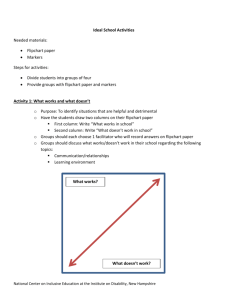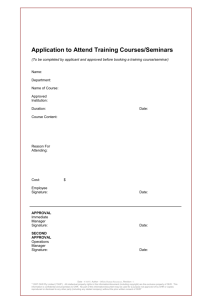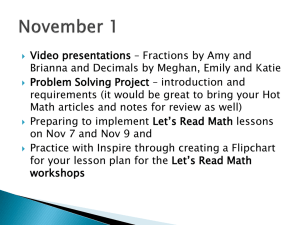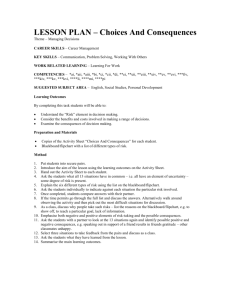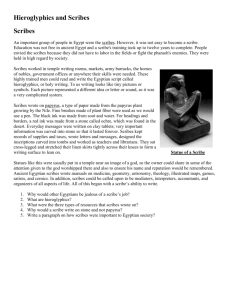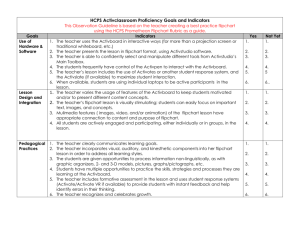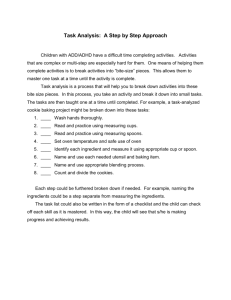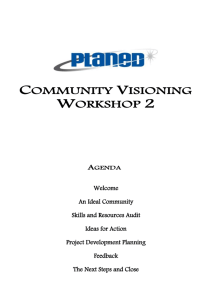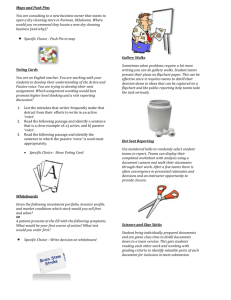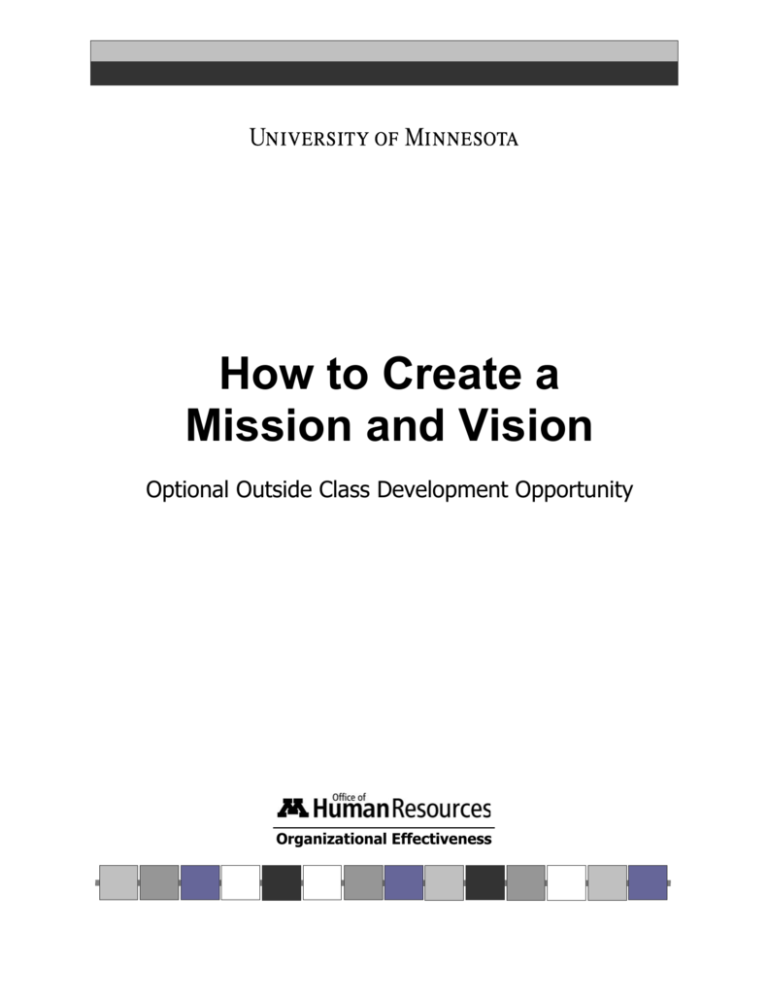
How to Create a
Mission and Vision
Optional Outside Class Development Opportunity
Organizational Effectiveness
2008 by the Regents of the University of Minnesota. All rights reserved.
These materials were developed and produced by Organizational Effectiveness, University of Minnesota, Office of Human
th
Resources, 200 Donhowe Building, 319 15 Ave SE Minneapolis, MN 55455.
The University of Minnesota is committed to the policy that all persons shall have equal access to its programs, facilities, and
employment without regard to race, religion, color, sex, national origin, handicap, age, veteran status, or sexual orientation.
This publication is available in alternative format upon request. Contact Organizational Effectiveness at 612-626-0774 or send an
e-mail to orgeff@umn.edu
Revised February 12, 2008
Mission/Vision Development
OBJECTIVE:
To facilitate the process of a group developing a mission or vision
statement.
TIME REQUIRED: Varies depending on size of group. Approximately 1½ to 2½ hours.
MATERIALS:
- Flipchart paper
- Markers
- Masking Tape
- Pens or Pencils
- Worksheets
PROCEDURE:
Begin by explaining the difference between a vision and a mission:
Vision: Statement about where the group is headed; how things
will look if the group is successful.
Mission: Statement about a group’s purpose; it explains why the
group exists, what the group is supposed to do.
You should have talked with the leader of the group in advance to
determine whether you should be working on a vision or a mission
statement. Explain that both vision and mission are the foundation
for our work. These kind of statements can help direct what we do
day-to-day (objectives, tactics). Tell him/her that the most effective
teams are those that are aligned around a single vision/mission. In
these teams, all members no matter what their position or jobs are
pointed in the same direction. They have a good sense of what they
need to do individually because they understand why the group
exists (mission) and because they have a picture of the future
(vision).
DISCUSSION:
As noted above you may want to use some additional exercises as
prompts to writing a mission or vision. As a minimum have group
members brainstorm answers to these questions:
1.
2.
3.
4.
5.
Who are our clients/customers?
What products/services do we provide?
What do we do best?
What do we do that no one else can do?
What values govern our work?
Creating a Vision and/or Mission Statement
Page 1
Mission/Vision Development, continued
Mission/Vision Development
Write responses to these questions on flipchart paper and post these sheets on the
wall. Have participants look at these sheets; ask them to spend five minutes writing
their own version of the group’s mission/vision statement. Tell them to work alone and
not to be worried about specific wording.
Next, divide the group into 4 or 5 groups of 3-5 people (you can do this exercise with as
few as 3-4 or as many as 6 groups, if necessary). Move these groups to four corners of
the room. Ask each group to designate one person to serve as “scribe”.
Explain that this exercise will involve a series of 5-minute discussions about the
mission/vision statements that have been developed by each individual. There will be
one 5-minute discussion for each group (example: if you have four groups, you will have
4 discussions). The same group members will stay together for all of the discussions.
The only people who will move are the scribes.
Start the first session by telling the groups that all participants should begin by sharing
the statement they wrote. After they have shared these ideas, they should look for
common themes. The scribes take notes on what they are hearing. At the end of the
first 5 minutes, ask the scribes to move to the next group. As a new scribe comes into
the group, the members should continue their discussion.
The facilitator should continue to call time at the end of each 5-minute interval. The
scribes should keep moving until they have heard each group. Then ask the scribes to
move to a quiet place where they will compare notes and attempt to write a draft of a
mission/vision statement.
As facilitator, you may need to coach the scribes to get them started. Give them lots of
flipchart paper and tell them to take a “first pass” at their statement by putting pen to
paper. Allow them 20-25 minutes to write. Remind them they are writing a draft that the
entire group will approve.
While they are writing, the other group members can take a break or do some other
activity. These other activities might include prioritizing a list of hot topics (using colored
dots), developing a list of objectives that will support the mission/vision statement, or
dividing into groups and brainstorming ways to deal with several important issues that
face the group.
Page 2
OHR/Organizational Effectiveness
Mission/Vision Development, continued
Mission/Vision Development
After the scribes have finished, have them present their draft to the group. Ask for
comments – including additions and deletions. You should lead this discussion. The
scribes should have written their draft on a sheet of flipchart paper. As the group makes
changes, you can write on the flipchart draft. When all discussion has ended, ask all
group members to approve the mission/vision statement.
As a follow-up, you can rewrite the edited version of the statement on a new sheet of
flipchart paper. Ask all group members to sign their name on the sheet to show their
approval of the statement. You might also encourage the group leader to have copies
of the statement reproduced for all members of the group.
Creating a Vision and/or Mission Statement
Page 3
Mission/Vision Development, continued
SAMPLE WORKSHEET
Your mission/vision for this team is:
Notes from your teammates:
Mission/vision in “final form”:
Page 4
OHR/Organizational Effectiveness
Goals and Objectives
SAMPLE WORKSHEET
Team Goals and Objectives: What can this team do to make the vision come to life?
Personal Goals and Objectives: What can I do to be sure that we realize our vision?
How will I have impact and offer contribution to this team?
Creating a Vision and/or Mission Statement
Page 5
Example of Department Mission Statement
Office of Human Resources Mission and Functions
The Office of Human Resources (OHR) is the system-wide support unit responsible for
assisting all campuses, colleges and administrative units in the management of their
human resources. The mission of OHR is to assist the University in accomplishing its
primary purposes by attracting, developing and retaining a productive and diverse
workforce.
The senior management of the University expects OHR to perform the following
functions:
to develop, maintain, disseminate and interpret university policies and insure
compliance with such policies as well as with state or federal mandates
to assist managers and supervisors in the hiring, development, retention and
evaluation or all employees
to accomplish the range of transaction processing requirements required to carry
out the day-to-day employment practices of the institution
to provide on-going monitoring, analysis, and reporting or demographics and
related information about the workforce
to provide opportunities for faculty, other academic employees, and staff to
enhance their competence through a variety of staff development programs and
services
to support senior management’s decision-making related to compensation and
benefits by supplying up-to-date information and analyses of internal and
external conditions such as market data
to manage the relationship between the University and its various organized
bargaining units by negotiating all contracts and assisting with the administration
of these contracts
Page 6
OHR/Organizational Effectiveness
Example Unit of Mission Statement
Organizational Effectiveness - Vision, Mission and Operating
Principles
Vision
The Organizational Effectiveness division is the University of excellence, where learning
and development come together.
Mission
The Organizational Effectiveness division serves as the University’s gateway to training,
development and consulting resources that build organizational capacity, increase
individual capabilities, and promote a culture of excellence. Through collaboration with
institutional stakeholders, the division ensures the University’s mission and goals are
addressed strategically and systemically.
Operating Principles
These principles provide a common language and understanding for the work we do
and how we do it. They are also an accountability tool that explains what we can expect
from each other and what our clients/customers can expect from us.
1. We highly value honesty, trust and mutual respect in our interactions with each other
and those we serve.
2. We use a “teach to fish” approach that moves from instructing clients to co-leading to
client self-sufficiency.
3. We strive to be a fun community where we enjoy the workplace and each other.
4. We are a learning community and we will encourage every individual to enhance
her/his personal professional growth through a wide variety of experiences.
5. We treat our mistakes and failures as learning opportunities.
6. We recognize our responsibility to model organizational best practices.
Creating a Vision and/or Mission Statement
Page 7

